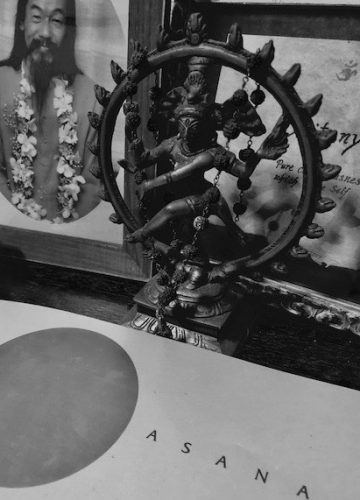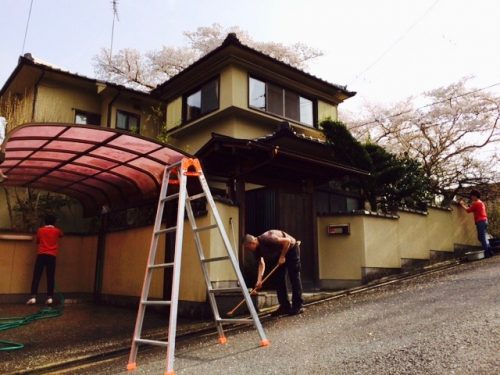Monday June 25, 2018 NYC
Today we would like to introduce the second article of the series Actual Practice of Yoga in Everyday Life. This is a translation of the Mahayogi Mission in Japan’s blog from April 28, posted just three weeks after Sanatana Dharma Avatara Mela (Ceremony of the Divine Manifestations), the occasion in which Chaitanya gave the speech that is now available to read in Pranavadipa Vol. 43, the current issue, and the behind the scenes writing process for which is also introduced in our blog Echo from the Cave: 80. We decided to share the translation of this article because we find that it provides an example of how a seeker takes up courage and continues to battle against his own mind, all for the transformation of the Self: the journey to Freedom.

Actual Practice of Yoga in Everyday Life 2: Asana that is Effective for the Mind
Lately, I have been thinking about the mind day after day.
However, until now, the fact is that I’ve never removed my mind from myself, thinking: “This mind is thinking like this, feeling in such and such a way.” Instead, most of the time, it’s been more like this, “I think this way, I feel that way.” After establishing the habit of discrimination between the thoughts in my mind and the Truth, I feel like I’m finally starting to be able to see the mind from a bird’s eye view.
I have learned from the teachings of Yoga about the mechanism of the mind, I have understood it, which gave me a satisfactory explanation and I practiced discrimination between the Truth and the thoughts in my mind. Nevertheless, even if I were to think, “Great, I am steady, my mind is not being shaken!” as soon as I face an unexpected circumstance in daily life, the mind’s habits, tendencies, and their root cause—attachments—start coming out of the woodwork. Oh well, I am so far from being steady…
My mind, seemingly being in a good condition, has actually been grasping various things that could become the root causes of suffering, in a tricky way that was not visible to me. Or, the past subconscious impressions (sanskara) had not been eliminated.
The mind is really formidable.
It was that mind that decided to change because it did not want to accept the way I was in the past, and it was that very same mind that tricked me while I was working hard at dismantling it, and unbeknownst to me, was growing roots of new attachments. The fact that I was unable to notice it is the proof that my discrimination was superficial. My being complacent, from the sense of “I am doing the best I can”, manifested as a result of the fact that I was not working hard enough.
Being confronted with this, I couldn’t even trust myself enough to ask my own self. Oftentimes when that happens, I’m thinking too much about this and that, about either the past or the future, so I concluded that it would never end no matter how far I go. The mind’s conditions change depending on the season, the day, the time… It’s not easy to shut this damn thing up.
If the practice of bhakti or of discrimination alone is not enough, then let me reconsider the entirety of my sadhana again, I thought. Then, the conclusion I came to after pondering thoroughly was “practicing asana”—let me go back to the mindset I had when I first started attending class and restart the practice of yama, niyama, and asana, which are the basics of raja yoga. I determined to go through it again, and since then I have been practicing asana carefully every day. I practice asana thoroughly, precisely, and solidly until I get to the point where I’m not able to think anymore after that.
My asana is nothing like the lithe, light, beautiful kind, rather my inflexible body squeaks and screams—it is tapas (heat) itself. But that actually works best for me. It captures the complacent, lazy mind, and makes it disciplined (tapas), and then the mind shuts up (mauna) for a while.
Two hours of asana and meditation. Then, its lingering sensation continues for about two hours afterwards. Let’s say I sleep for 7 hours. That’s a total of 11 hours. Then all I have to do is to shut up the mind for the other 13 hours. As soon as I find spare time, I read scriptures (svadhyaya), or chant the name of my favorite deity and think about it (ishvara pranidhana). However, you can’t practice only those things all the time during the day. So while working, while at home, you concentrate on the task at hand. Just simply concentrate! Do not receive the results or the impressions. If we practice that way, then we ought to be able to live in the “Now,” moment by moment, without being swung around by the thoughts in the mind.
Out there in the world nowadays, asana is said to be effective for beauty and diet. However, practically, it is actually the most effective for the mind!!
Chaitanya (Kyoto)
Translation from the Mahayogi Mission-Kyoto Blog on April 28, 2018









 Often times we might feel that we want freedom from our mind. Wherever we go, our mind follows. How can we be free? Herein lies the beauty of Yoga, because it deals directly with our mind so that we can be free of it. Nowadays, many people may see Yoga as the practice of asana, meant to relieve daily stress or to get exercise. But Yoga is actually for the purpose of coming to know our real and pure Self. And Yoga teaches that if we still the waves of our mind, the real and pure Self emerges alone. But then how do we do this? Indeed, asana practice is one of the practices that will prepare our mind to become calmer so that we can meditate in stillness. Yet many of us might have experienced that it is not so easy to still the mind, even though we try to sit for meditation. Why? Our mind is constantly, or if not constantly, it is at least more often than not caught up by daily situations and matters—our mind moves so easily. That is where the actual practice of Yoga in daily life comes into play as a way to deal with our own mind. Don’t we want to free ourselves from that?
Often times we might feel that we want freedom from our mind. Wherever we go, our mind follows. How can we be free? Herein lies the beauty of Yoga, because it deals directly with our mind so that we can be free of it. Nowadays, many people may see Yoga as the practice of asana, meant to relieve daily stress or to get exercise. But Yoga is actually for the purpose of coming to know our real and pure Self. And Yoga teaches that if we still the waves of our mind, the real and pure Self emerges alone. But then how do we do this? Indeed, asana practice is one of the practices that will prepare our mind to become calmer so that we can meditate in stillness. Yet many of us might have experienced that it is not so easy to still the mind, even though we try to sit for meditation. Why? Our mind is constantly, or if not constantly, it is at least more often than not caught up by daily situations and matters—our mind moves so easily. That is where the actual practice of Yoga in daily life comes into play as a way to deal with our own mind. Don’t we want to free ourselves from that?